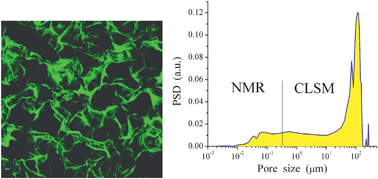Characterisation and performance of hydrogel tissue scaffolds
Abstract
Porosity over a broad range (typically 0.001–300 μm in diameter) of tissue scaffolds provides appropriate conditions for diffusion and adsorption of small molecules and

* Corresponding authors
a
School of Pharmacy & Biomolecular Sciences, University of Brighton, Brighton, UK
E-mail:
v.gunko@brighton.ac.uk, s.mikhalovsky@brighton.ac.uk
Tel: +441273 642034
b
Institute of Surface chemistry, 17 General Naumov Str., Kiev, Ukraine
Fax: +38044 4243567
Tel: +38044 4229627
c
Materials Division, National Physical Laboratory, Queens Road, Teddington, Middlesex, UK
E-mail:
paul.tomlins@npl.co.uk
Porosity over a broad range (typically 0.001–300 μm in diameter) of tissue scaffolds provides appropriate conditions for diffusion and adsorption of small molecules and

 Please wait while we load your content...
Something went wrong. Try again?
Please wait while we load your content...
Something went wrong. Try again?
V. M. Gun'ko, L. I. Mikhalovska, I. N. Savina, R. V. Shevchenko, S. L. James, P. E. Tomlins and S. V. Mikhalovsky, Soft Matter, 2010, 6, 5351 DOI: 10.1039/C0SM00617C
To request permission to reproduce material from this article, please go to the Copyright Clearance Center request page.
If you are an author contributing to an RSC publication, you do not need to request permission provided correct acknowledgement is given.
If you are the author of this article, you do not need to request permission to reproduce figures and diagrams provided correct acknowledgement is given. If you want to reproduce the whole article in a third-party publication (excluding your thesis/dissertation for which permission is not required) please go to the Copyright Clearance Center request page.
Read more about how to correctly acknowledge RSC content.
 Fetching data from CrossRef.
Fetching data from CrossRef.
This may take some time to load.
Loading related content
